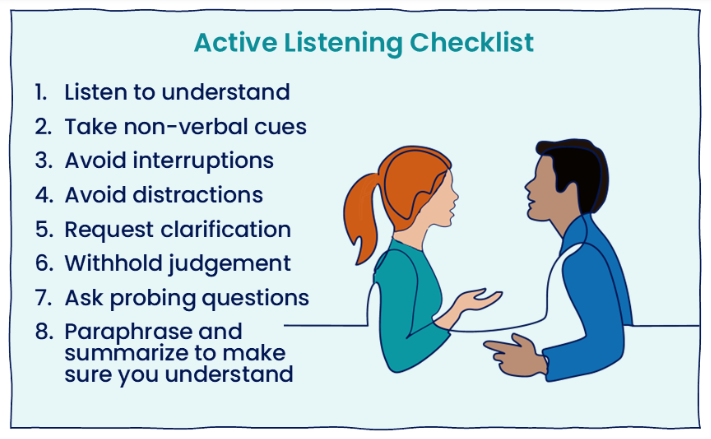
Active Listening:
Small Habit, Big Difference
We’ve all heard the noise and experienced the conflict in the air these days. In politics. On social media. At work. In families. With the holiday season just around the corner, we thought it would be a good time to talk about the one skill that can help lower the volume and turn conflict into connection. Better still, it’s something that can help strengthen any relationship.
Active listening is the communication skill that turns an ordinary conversation into genuine connection.
Most of us like to think we’re good listeners. We nod, stay quiet, maybe even repeat what someone just said. But real listening isn’t about waiting for your turn to talk. It starts with being fully present and dedicated to truly understanding what the other person is trying to communicate.
It’s a tool therapists, leaders, and effective communicators all rely on. And the good news is, anyone can learn it.
What is active listening?
Active listening is more than staying quiet while someone else talks. It’s about engaging with both their words and emotions, creating a two-way exchange instead of a one-way data dump.
Researchers describe three obvious dimensions of listening:
- Cognitive: Paying attention to what’s said and what’s implied with tone, pauses, and context.
- Emotional: Staying calm, compassionate, and curious especially when the topic is difficult.
- Behavioral: Showing engagement through nonverbal signals — eye contact, nods, and small affirmations that say, “I’m with you.”
All three of these dimensions must be functional during active listening.
Why It Matters
Active listening doesn’t just make people feel good — it measurably improves relationships, satisfaction, and trust.
Studies have shown that when managers actively listen, employees report higher job satisfaction and loyalty. In healthcare, patients who feel heard are more likely to follow treatment plans. In friendships and families, it’s the difference between comfort and conflict.
Put simply, being heard is a basic human need, and active listening meets that need head-on.
Active Listening in the Real World
- At work: Managers who listen actively foster psychological safety, a foundation for creativity and problem-solving.
- In relationships: Couples who listen without interrupting or defending report higher satisfaction and fewer misunderstandings.
- For parents: Listening without jumping in to fix builds trust and helps kids develop emotional awareness.
- For yourself: Learning to slow down and listen also quiets your own internal chatter — a skill that’s as good for stress as it is for connection.
How to Practice Active Listening
Show You’re Actually Listening
That means being physically and mentally present. Put away distractions. Close the laptop. Turn the phone face down.
Make small gestures that show engagement. Think about nods, eye contact, phrases like “I see” or “That makes sense.” These simple cues tell the speaker, you have my attention.
- Ask, Don’t Assume
Use open-ended questions like, “What’s that been like for you?” or “Can you tell me more about that?” Then stop talking.
If you’re not sure what someone means, ask for clarification instead of guessing. You might say, “It sounds like you’re frustrated about more than just the project — is that right?”
- Reflect Back— With Empathy
This step is where the magic happens. Reflecting shows you’ve both heard and understood.
Example: “It sounds like you’re trying to keep up, but you’re feeling stretched too thin.” That sentence conveys understanding and emotion without judgment — and often opens the door for the speaker to go deeper.
- Stay Curious
It’s natural to want to jump in with advice, reassurance, or your own story. But that often shifts attention back to you.
Instead, pause and silently ask yourself, “Why am I talking?” or “Am I still listening?”
The goal isn’t to fix the problem — it’s to understand the person.

Common Listening Styles (And How to Adjust Yours)
Communication experts have identified four listening styles
- Task-oriented: Focused on efficiency and getting things done.
- Analytical: Aims to solve problems or assess information objectively.
- Relational: Tunes in to emotion and connection.
- Critical: Evaluates both message and messenger.
None of these are “wrong.” But self-awareness matters. If you usually default to analytical or task-oriented listening at work, your spouse or friend might need more relational listening. Many personal interactions are seeking empathy, not analysis or problem-solving. The best communicators move fluidly among styles, depending on what the situation calls for. But each style should result in a person feeling heard.
Try a 30-Second Listening Reset (great for your next family gathering)
When a conversation starts going sideways with tension, distraction, or misunderstanding, pause for 30 seconds:
- Take a slow breath.
- Unclench your jaw and lower your shoulders.
- Mentally repeat: Be curious, not judgmental.
- Re-focus on the other person’s face, tone, and words.
That quick reset can turn potential conflict into understanding and can help avoid all kinds of misery.
How to Tell You’re Doing It Right
- The other person feels calmer or more open after talking to you.
- They volunteer more information without prompting.
- You spend less time arguing and more time understanding (be honest here).
- You leave the conversation feeling connected, not drained.
The Bottom Line
Active listening is simple but transformative.
Be present. Be curious. Be kind.
You can get better and better at active listening the more you practice. The goal isn’t to agree or advise. If you actually LISTEN, you will make someone feel heard. And you are likely to strengthen your connection and gain some perspective during the process.